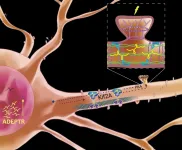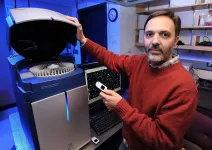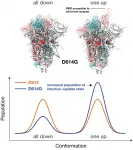(Press-News.org) Sophia Antipolis - 17 April 2021: Elevated blood pressure, high cholesterol and diabetes increase the risk of heart disease. But a large study today reveals that in people with these conditions, increasing activity levels is associated with a reduced likelihood of heart events and mortality. The research is presented at ESC Preventive Cardiology 2021, an online scientific congress of the European Society of Cardiology (ESC).1
Study author Dr. Esmée Bakker of Radboud University Medical Center, Nijmegen, the Netherlands said: "Previous research showed that improvements in physical activity are beneficial to health. However, those studies were performed in the general population. In our study, we were interested to see if there were similar effects in individuals with cardiovascular risk factors such as high blood pressure, high cholesterol, and diabetes."
The study included 88,320 individuals from the LifeLines Cohort Study. Participants underwent a physical examination and completed questionnaires about their medical history and lifestyle including exercise. The questionnaires were repeated after approximately four years.
Study participants were divided into five groups according to activity levels at baseline and four years: large reduction, moderate reduction, no change, moderate improvement, and large improvement.2 Participants were followed-up for a median of seven years after the first assessment for the occurrence of cardiovascular disease or death.
A total of 18,502 (21%) individuals had high blood pressure, high cholesterol, and/or diabetes at the start of the study. The average age of this group was 55 years. After adjusting for age, sex, and baseline physical activity, the researchers found that those with a moderate to large improvement in physical activity were around 30% less likely to develop cardiovascular disease or die during follow-up compared to those who did not change their activity level.
The remaining 69,808 (79%) participants did not have high blood pressure, high cholesterol, or diabetes at the start of the study. The average age of this group was 43 years. After adjusting for age, sex, and baseline physical activity, the researchers found that those with large reductions in physical activity had a 40% higher risk of cardiovascular disease or death compared to those who did not change their activity level.
Dr. Bakker said: "Our study suggests that to prevent heart attacks and strokes and boost longevity, healthy individuals should maintain their physical activity levels, while those with risk factors need to become more active. The associations we found were even more pronounced in people who were relatively sedentary at the start of the study, indicating that inactive people have the most to gain."
To prevent heart disease, European guidelines recommend at least 150 minutes a week of moderate
intensity or 75 minutes a week of vigorous intensity aerobic physical activity or an equivalent combination.3
Dr. Bakker said: "If you are currently sedentary, walking is a good activity to start with. If you are already hitting the recommended amount, try doing 10 minutes more each day or increasing the intensity."
INFORMATION:
Authors: ESC Press Office
Tel: +33 (0)4 89 87 20 85
Mobile: +33 (0)7 8531 2036
Email: press@escardio.org
Follow us on Twitter @ESCardioNews
Notes to editor
Funding: The study was funded by the Dutch Ministry of Health, Welfare and Sport, the Dutch Ministry of Economic Affairs, and the University of Groningen, the Netherlands.
Disclosures: None.
References and notes
1Abstract title: Impact of cardiovascular health status on the association between changes in physical activity and major cardiovascular events and mortality among 88,320 adults: outcomes of the Lifelines Cohort Study.
2Change in physical activity was based on weekly metabolic equivalent of task (MET)-minutes. When MET-minutes are translated to minutes of running per week (10 km/hour), the five groups are: large reduction (drop of at least 150 minutes), moderate reduction (25-150 minutes less), no change, moderate improvement (25-150 minutes more), large improvement (at least 150 minutes more).
3Piepoli MF, Hoes AW, Agewall S, et al. 2016 European Guidelines on cardiovascular disease prevention in clinical practice. Eur Heart J. 2016:37:2315-2381.
About the European Association of Preventive Cardiology
The European Association of Preventive Cardiology (EAPC) is a branch of the ESC. Its mission is to promote excellence in research, practice, education and policy in cardiovascular health, primary and secondary prevention.
About ESC Preventive Cardiology 2021 #ESCPrev2021
ESC Preventive Cardiology 2021, formerly EuroPrevent, is the leading international congress on preventive cardiology and the online annual congress of the European Association of Preventive Cardiology (EAPC) of the European Society of Cardiology (ESC).
About the European Society of Cardiology
The European Society of Cardiology brings together health care professionals from more than 150 countries, working to advance cardiovascular medicine and help people lead longer, healthier lives.
Information for journalists about registration for ESC Preventive Cardiology 2021
ESC Preventive Cardiology 2021 takes place 15 to 17 April online. Explore the scientific programme.
* Free registration applies only to accredited press.
* Credentials: A valid press card or appropriate letter of assignment with proof of three recent published articles (cardiology or health-related or referring to a previous ESC event). Read the ESC media and embargo policy.
* The ESC Press Office will verify the documents and confirm by email that your press accreditation is valid.
* The ESC Press Office decision is final regarding all press registration requests.
Tokyo, Japan - Researchers from Tokyo Metropolitan University and Hosei University have discovered a new species of large, tropical centipede of genus Scolopendra in Okinawa and Taiwan. It is only the third amphibious centipede identified in the world, and is the largest in the region, 20 cm long and nearly 2 cm thick. It is also the first new centipede to be identified in Japan in 143 years, testament to the incredible biodiversity of the Ryukyu Archipelago.
Scolopendra is a genus of large, tropical centipede, one of the original genera named by the father of modern taxonomy himself, Carl Linnaeus. They are strong predators in any soil ecosystems they inhabit, with around 100 different species found in tropical regions around the world. Of these, only five have been ...
Research shows that a new telescope could detect a potential signature of life on other planets in as little as 60 hours.
"What really surprised me about the results is that we may realistically find signs of life on other planets in the next 5 to 10 years," said Caprice Phillips, a graduate student at The Ohio State University, who will share preliminary findings at a END ...
From engineered pandemics to city-toppling cyber attacks to nuclear annihilation, life on Earth could radically change, and soon. Scientists will forecast the fate of the planet at a END ...
Tarantulas are among the most notorious spiders, due in part to their size, vibrant colors and prevalence throughout the world. But one thing most people don't know is that tarantulas are homebodies. Females and their young rarely leave their burrows and only mature males will wander to seek out a mate. How then did such a sedentary spider come to inhabit six out of seven continents?
An international team of researchers, including Carnegie Mellon University's Saoirse Foley, set out on an ancestry.com-like investigation to find the answer to this question. They looked to the transcriptomes, ...
Faced with the tragic loss of the Arecibo observatory in Puerto Rico and the often prohibitive cost of satellite missions, astronomers are searching for savvy alternatives to continue answering fundamental questions in physics.
At a END ...
JUPITER, FL--Making memories involves more than seeing friends or taking photos. The brain constantly adapts to new information and stores memories by building connections among neurons, called synapses. How neurons do this--reaching out arm-like dendrites to communicate with other neurons--requires a ballet of genes, signaling molecules, cellular scaffolding and protein-building machinery.
A new study from scientists at Scripps Research and the Max Planck Florida Institute for Neuroscience finds a central role for one signaling molecule, a long, noncoding RNA that the scientists named ADEPTR.
Using a variety of technologies, including confocal and two-photon microscopy, they track ADEPTR's moves, watching as it forms, travels, amasses at the ...
AMES, Iowa - A lot is riding on the continued advancement of plant sciences.
Take the food supply, for starters. Climate change and population growth will continue to pose challenges in the future, and crop production will require innovation and progress by plant scientists in order to keep pace. It isn't an overstatement to say that populations around the world will go hungry if plant science stagnates, said Gustavo MacIntosh, a professor in the Roy J. Carver Department of Biochemistry, Biophysics and Molecular Biology at Iowa State University.
"At the end of the day, either you eat plants or you eat food that ate plants," MacIntosh said. "Plants are the basis for the food we have."
MacIntosh predicts ...
When the Electron Ion Collider received the go-ahead in January 2020, it became the only new major accelerator in the works anywhere in the world.
"All the stars aligned," said Elke-Caroline Aschenauer, Brookhaven National Laboratory Staff Scientist and a leader in developing the EIC plans. "We have the technology to build this unique particle accelerator and detector to do the measurements that, together with the underlying theory, can for the first time provide answers to longstanding fundamental questions in nuclear physics."
The EIC isn't the only Brookhaven project poised to reshape nuclear and particle physics. Forthcoming data from the Relativistic Heavy Ion Collider could finally detect the elusive chiral magnetic effect. Meanwhile, planned accelerators could run on sustainable ...
LOS ALAMOS, N.M., April 16, 2021 -- Large-scale supercomputer simulations at the atomic level show that the dominant G form variant of the COVID-19-causing virus is more infectious partly because of its greater ability to readily bind to its target host receptor in the body, compared to other variants. These research results from a Los Alamos National Laboratory-led team illuminate the mechanism of both infection by the G form and antibody resistance against it, which could help in future vaccine development.
"We found that the interactions among the basic building blocks of the Spike protein become ...
Researchers within the Biomedicine Discovery Institute at Monash University have made a breakthrough in understanding the role played by high-risk immune genes associated with the development of rheumatoid arthritis (RA).
The findings, published in Science Immunology, were the result of a seven-year collaboration led by Monash University, involving Janssen Research and Development, USA and the Karolinska Institute, Sweden.
Certain immune system genes, called Human Leukocyte antigen (HLA)-DR4, cause an increased susceptibility to RA. In this study, using mice genetically ...








